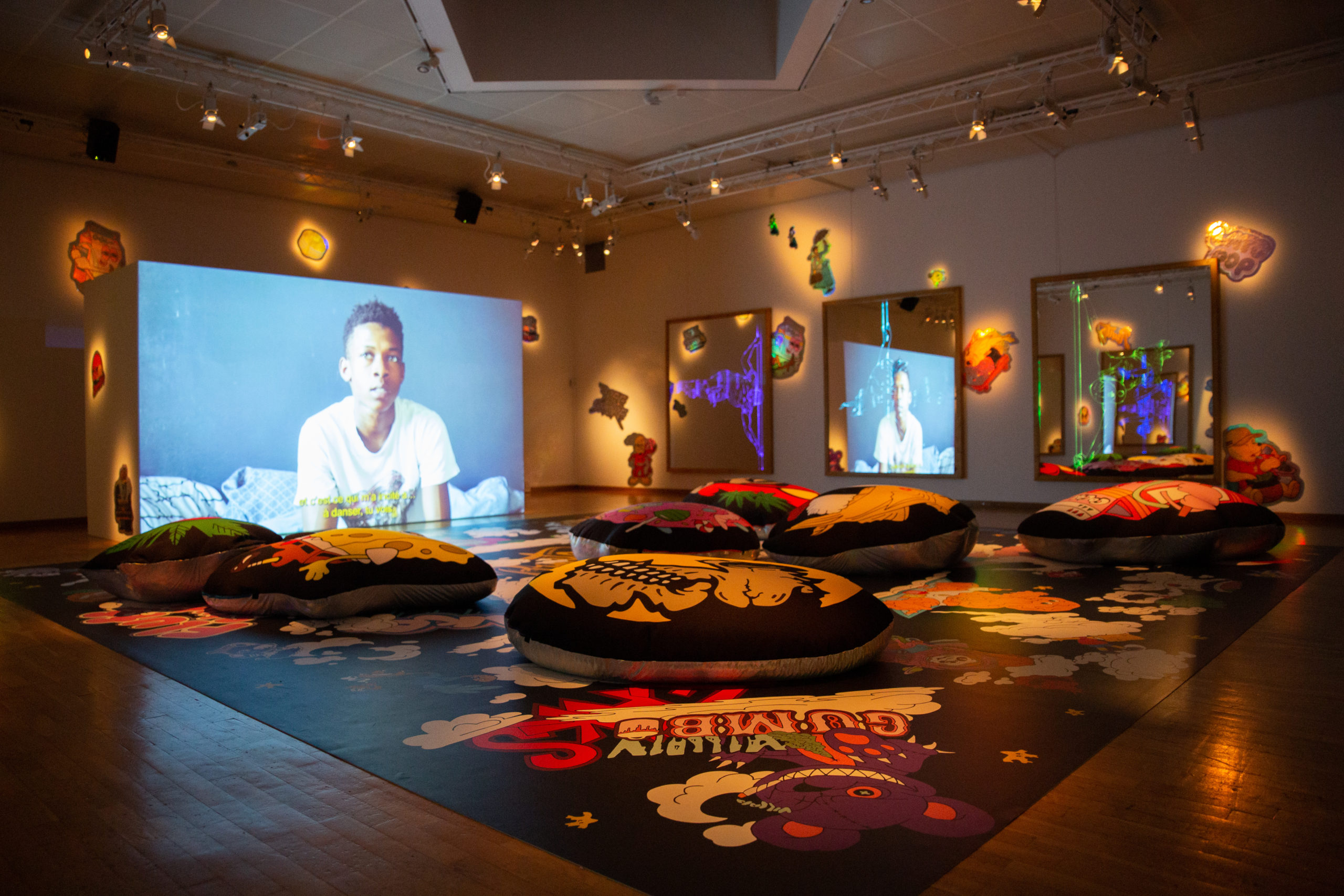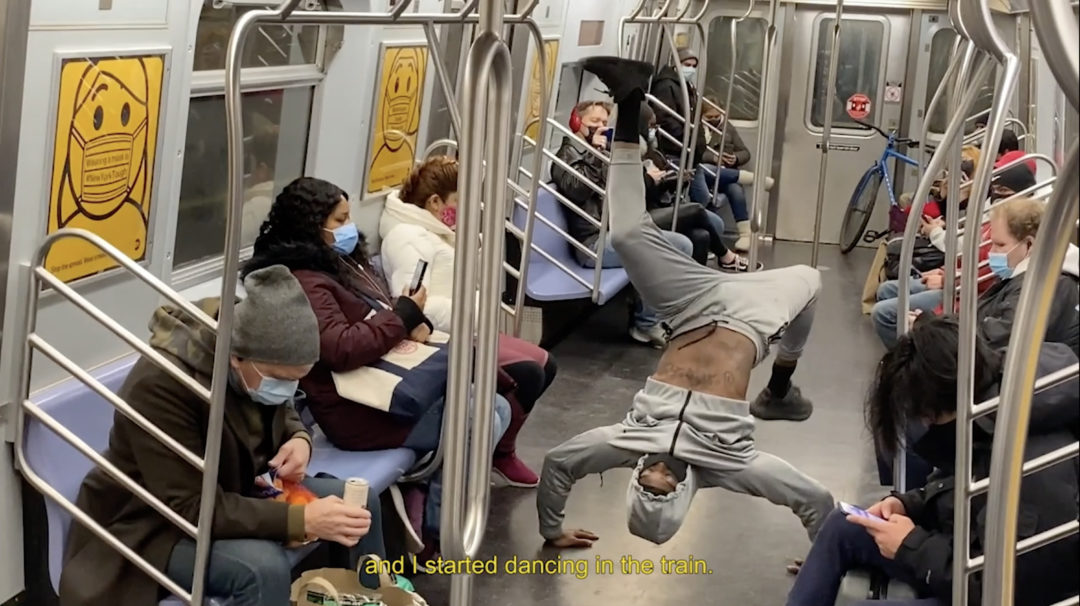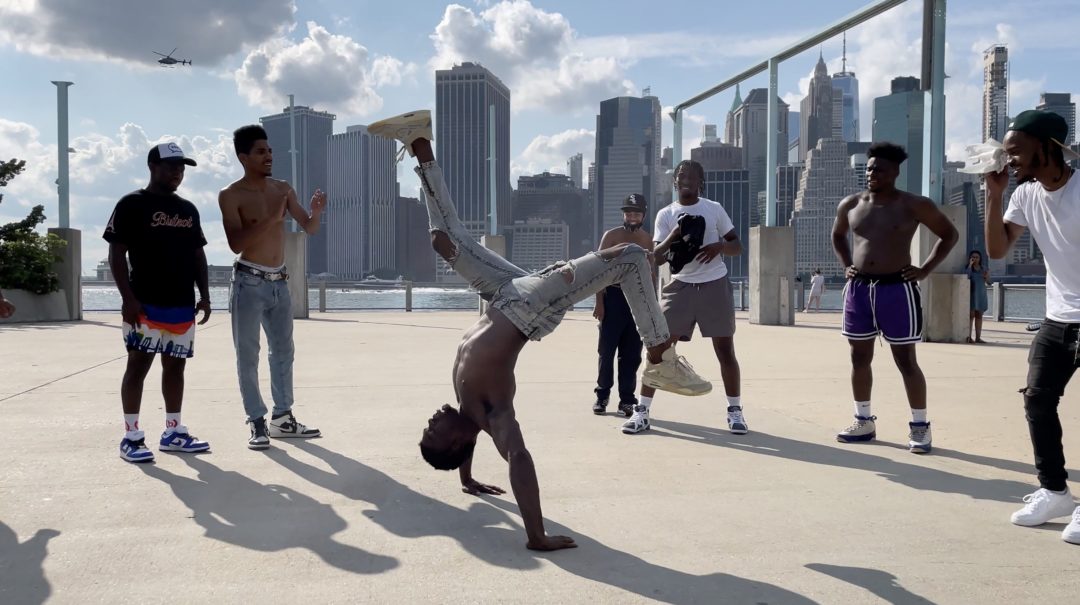Rafaela Lopez at Forum Meyrin

Rafaela Lopez, Showtime, Curator: Fanny Serain,
Forum Meyrin, Canton of Geneva, from 24 April to 18 May 2024.
The Forum Meyrin, in the canton of Geneva, Switzerland, is hosting the exhibition “Showtime” by Rafaela Lopez (born in Paris in 1988, lives and works between Paris and New York), centred on the film of the same name, which is being presented in a plastician environment for the first time. The space is occupied by a huge carpet on which are placed imposing cushions facing the large screen that projects the film, while six rectangular mirrors – three times three – punctuate the side walls of the room. The gaps between them are studded with giant stickers depicting various characters: a chef wearing a chef’s hat, holding a dish in his left hand and smoking with the other; the multiplying figure of Mary Poppins, taking off, satchel in hand and umbrella open; or a teddy bear sitting against a wall, wearing a polo shirt and cap, spider web tattooed on his neck, one hand plunged into a small tub of grass on his lap. Monochrome figures of dancers moving around a metal bar are sketched on the mirrors. The carpet and fabric seats are also covered in various zany creatures, such as Sponge Bob smoking a joint, a fairly tipsy M&M’s or a giant cannabis leaf… Since 31 March 2021, it has been legal to possess three ounces – or 24 grams – of marijuana in New York State. The stickers and other representations on display in the exhibition are nothing more than reproductions of some of the packaging used by brands distributing these products, which until recently were illegal. With the scene thus set, the projection can begin.

Avec les danseurs new yorkais Jah Mc Millon, Jerod Murphy, Forty Smooth, Talented Sparkz, Tyke Tuner
Production Heko avec le soutien de la Fondation des Artistes et de la Direction Régionales des Affaires Culturelles d’Ile de France
Crédit photo : Daisy Kim Lehmann
Rafaela Lopez’s work spans video, performance, sculpture, drawing and participatory projects. In her work, she uses marginalised creative practices and popular culture – including TV series, reality shows and pop music – to question the social role of art and the possibility of breaking away from the status to which we are assigned. In ‘Showtime’, she follows a group of six young African-Americans who meet at the Bedford Avenue underground station in New York. On the L train that links Brooklyn to Manhattan via 14th Street, they put on a show. As they travel back and forth across the Lower East Side, the Bronx and Brooklyn, they turn each train into a temporary dance floor. These young dancers practise Litefeet, an urban dance that originated in the Bronx in the mid-2000s and combines several vernacular dances, a kind of male pole-dance for which the bars of the underground trains provide the ideal support. They all want their share of the American dream. The film begins with a series of words of advice and encouragement, such as “Prove yourself to yourself, not other” and “Success is my only option”, distilled from quotes uttered by self-made men who have risen from nothing to become the best in their field, and set to the rhythm of a remixed rap track by Dock jr, whose build-up illustrates the desire for social advancement that drives them. The first image shows a young African-American man with tattoos all over his bare chest. Facing the camera, he welcomes us to New York in a thick cloud of cannabis smoke that fills the terrace where he is standing. The shot lasts barely a handful of seconds but is enough to capture the atmosphere that pervades the film, reinforcing the feeling of freedom as the promise of all things possible. The next shot follows the back of the gang of African-American friends as they meet in the Bedford Avenue underground station in Brooklyn. These first two scenes contain all the ingredients for a film cut in two that evokes the hopes of young black working-class Americans for success, confronted with the social reality of a country full of paradoxes, exalting individual success even though the social reality is far more complex.
On the train, one after the other, they take hold of the bar around which they are going to wrap themselves, executing impressive figures to the millimetre. The configuration of an underground train means there’s no room for guesswork: a single mistake and you’re bound to fall, or collide with a passenger. The first part of the show is upbeat, luminous like the sun shining in New York, euphoric at times. It is marked by the confidence they have in themselves and the benevolence of the passengers. The scenes from Litefeet are interspersed with interviews with the young dancers, filmed most of the time in their homes, in the privacy of their own homes. Hailing from the Williamsburg district of Brooklyn, they are all around eighteen years old and talk about their dreams. They all say that dancing has helped them avoid a whole host of problems. For some of them, the bars in the underground are the same as those in a weight room. Although we can see them counting the one-dollar notes that satisfied passengers give them at the end of the show, money is not exactly their main motivation. In the metro, they are the centre of attention. They’re the ones you watch, the ones you applaud. Yet the film only shows the skyline of Manhattan, reflecting the social distance that separates the central New York island from these Brooklyn dancers. Like Jerod, whose parents’ flat has the best view of New York – in fact, it looks out over the towers towards Queensboro Plaza in Queens – Manhattan remains a horizon that is both near and far, accessible and yet unattainable.

Avec les danseurs new yorkais Jah Mc Millon, Jerod Murphy, Forty Smooth, Talented Sparkz, Tyke Tuner
Production Heko avec le soutien de la Fondation des Artistes et de la Direction Régionales des Affaires Culturelles d’Ile de France
Crédit photo : Daisy Kim Lehmann
By making pole dancing a male practice, Litefeet has broken down stereotypical gender codes. “Men don’t want to pole dance because they think you have to be a woman or behave like a woman to do it”, says one of the protagonists. Mixing hip hop and break dancing has added a touch of virility, hybridizing the practice. The end of the film is like a difficult return to reality. Adulthood is often the end of dreams. Jerod will soon be leaving New York for another state, while Jah, concentrating on his culinary career, dances this summer for the last time. Each of them seems to have put aside their aspirations in favour of a dream that is more accessible, more reasonable, more in line with what is expected of them. The cover version of “Bella ciao” remixed by Kid The Wizz that plays during the closing credits is all the more poignant. In “Showtime”, one of the protagonists defines the Litefeet as a twelve-second performance. The length of dreams.
Head image : Rafaela Lopez, Showtime
Avec les danseurs new yorkais Jah Mc Millon, Jerod Murphy, Forty Smooth, Talented Sparkz, Tyke Tuner
Production Heko avec le soutien de la Fondation des Artistes et de la Direction Régionales des Affaires Culturelles d’Ile de France
Crédit photo : Daisy Kim Lehmann
- From the issue: 109
- Share: ,
- By the same author: Candice Breitz, Banks Violette at BPS 22, Charleroi , Yoshitoro Nara at Guggenheim, Bilbao, Echos der Bruderländer à HKW, Berlin, Élodie Seguin at La BF15, Lyon,
Related articles
Streaming from our eyes
by Gabriela Anco
Don’t Take It Too Seriously
by Patrice Joly
Déborah Bron & Camille Sevez
by Gabriela Anco

